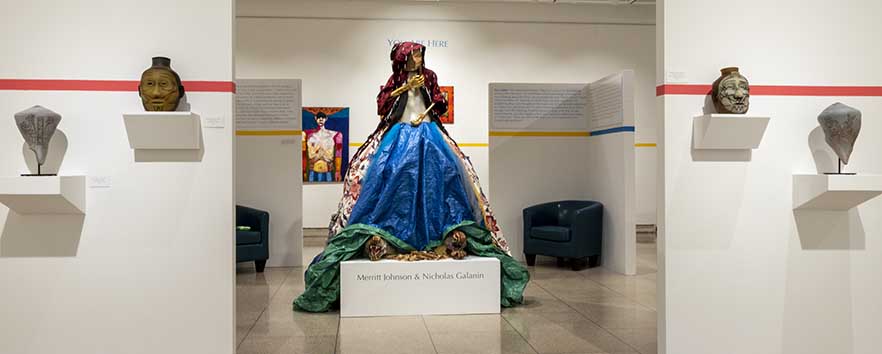Sheehan Gallery’s “You Are Here” Investigates Place and Identity
By Lara Hale

A towering feminine figure stands on a pedestal in Whitman College’s Sheehan Gallery. In place of her head is a tree stump, from which she is carving herself a new face. She wears a bustled floral-print gown in the 17th-century style of the Europeans who colonized the land, cut open to reveal a voluminous underskirt made of a blue plastic tarp, like those used to cover broken windows or build temporary shelter. The skeletal arms of her children thrust out from beneath the gown’s tent-like skirt.
The mixed-media sculpture, “Creation and Her Children” (2017) by Merritt Johnson and Nicholas Galanin, stands front and center of the Sheehan’s “You Are Here” exhibit, which shares the work of a number of contemporary artists who each have a personal connection to indigeneity. (Johnson is Mohawk and Blackfoot; Galanin is Tlingit and Unangax̂.) Curated by Sheehan Gallery Director Kynde Kiefel to support a course on Indigenous aesthetics introduced in the Fall 2021 semester by Lisa Uddin, associate professor of art history and visual culture studies, the exhibited works explore themes related to place and identity and draw from personal and collective histories and memories. The show is intended to encourage conversation within the campus community about the complex history of the college, which is located on traditional Cayuse, Umatilla and Walla Walla homelands, and what it means to be a participant in this history.
 Diverse Media, Common Themes
Diverse Media, Common Themes
“You Are Here” exhibits works in a wide range of media, including painted portraits by Ric Gendron, a member of the Arrow Lakes Band of the Confederated Tribes of the Colville Reservation; lithographs that merge historical photos with traditional quilt patterns by Apsáalooke artist Wendy Red Star; colorful landscapes by James Lavadour, a member of the Walla Walla tribe; and fiber art pieces constructed from wool blankets and embroidered by Marie Watt, a member of the Seneca nation. C. Maxx Stevens’ installation consists of nine vintage dollhouses, their almost ghostly interiors decorated with found objects and materials which impart the Seminole artist’s memories of her childhood and the places she has called home.
Also on display are many pieces by Whitman Alumnus of Merit for 2021 and member of the Choctaw tribe, Marcus Amerman ’81. In addition to masks and vessels made of blown and sand-carved glass he crafted in collaboration with Tlingit artist Preston Singletary, there are some of the intricately beaded images for which he is best known—a style he calls “photobeadalism.” These are complemented by elaborately beaded sashes and bags created by Amerman’s older brother Roger, who attended Whitman from 1976-1977.
Along with exploring identity and tradition, many of the works share a common theme of world-building, says Kiefel.
“I’d say all of these artists are sort of world creators. Maxx riffs on her dreams and then builds these imagined places—I feel like there’s an interesting dream quality to leaning into a dollhouse and immersing yourself in her miniature world. Ric has talked about how many of the beings in his portraits are otherworldly. And Marcus has also talked about wanting to live in a world completely made of beads.”
 Making a Statement
Making a Statement
In addition to sharing their stories through their work, several of the artists have talked about their backgrounds, inspirations and methods during interviews—both live and recorded—conducted specifically for “You Are Here.” In some cases, visitors can listen to an audio file or watch a video of the artist talking about their work. A few artists, including Marcus Amerman and Najavo artist Melanie Yazzie, have participated in live Q&A sessions. The last of these artist interviews takes place at 4 p.m. on Thursday, Dec. 2, when C. Maxx Stevens will speak via Zoom.
“It felt particularly important to not just have the usual little white square of artist statement text but, for those that were available, to actually hear their voices,” says Kiefel.